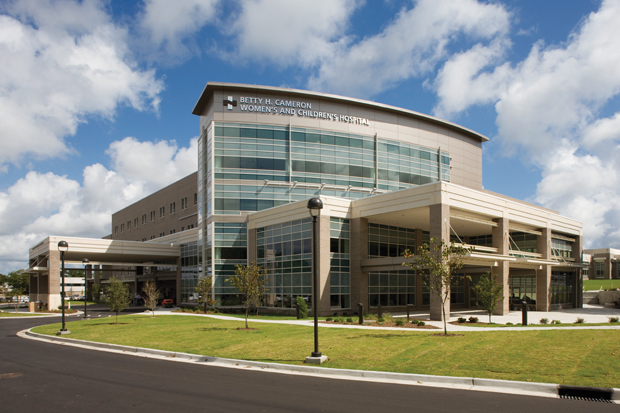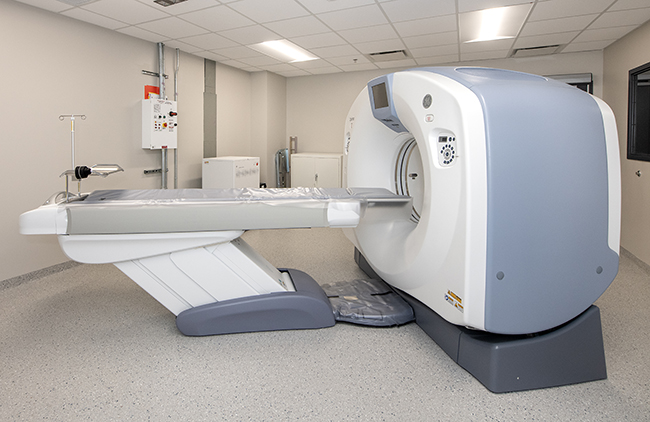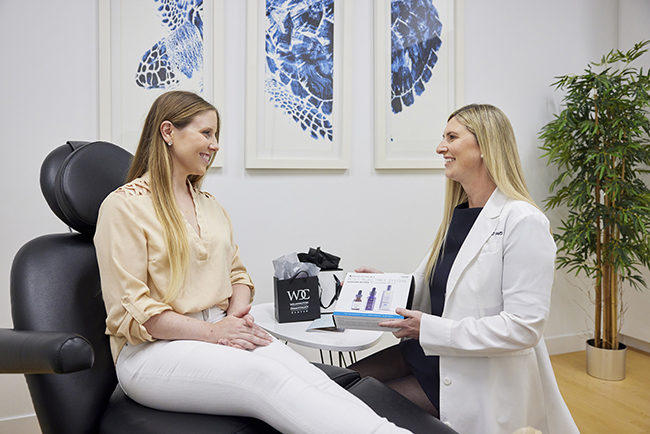Ahead of the Curve
06 Nov 2017
Betty H. Cameron Women’s & Children’s Hospital stays current with preventive healthcare for today’s child
By EMILY GORMAN FANCY

New parents can be overwhelmed with all the health concerns that come with early childhood, from meeting milestones, to antibiotic usage, to keeping up with well-check schedules. As children enter school and lifestyles become more hectic, children’s health concerns also evolve to cover things like screen time and sleep. Parents of school-age children ask themselves, are my children getting enough sleep? Are they spending too much time on their electronic devices?
Pediatric Preventative Healthcare
For pediatric services, Wilmington is fortunate to have Betty H. Cameron Women’s & Children’s Hospital, part of the New Hanover Regional Medical Center, which serves children from a seven-county region. Being treated in a hospital can be intimidating for the youngest patients, so to help make the experience as comforting as possible, the Cameron Hospital’s pediatric wing incorporates a bright, child-friendly design including a playroom and garden. To ensure a family-friendly and cohesive approach to pediatric care, pediatric anesthesiologists, hospitalists, and specialists collaborate on the best treatment plan for each patient.
“As pediatric care standards progress, pediatricians are making the effort to improve widespread use of antibiotics throughout our community in accordance with statewide and national goals to improve antibiotic stewardship,” says Dr. Lauren Gainor, pediatric hospitalist with Cameron Women’s & Children’s Hospital. “In pediatrics, physicians are making efforts to choose antibiotics that most specifically cover the bacteria causing an infection and not choosing the most broad-spectrum antibiotics automatically.” For example, according to Dr. Gainor, a pediatrician could choose the more narrow spectrum Ampicillin to cover community-acquired pneumonia in children as opposed to the more traditional, broad spectrum choice of Ceftriaxone, a third-generation cephalosporin antibiotic.
To reduce the length of hospital stays for pediatric patients, pediatric hospitalists are also transitioning children from intravenous to orally administered antibiotics as soon as possible. This also helps to defray medical costs.
Limiting Screen Time
In today’s high-tech world, children often begin navigating devices with ease by the time they enter school. According to a research study by PlayScience, more than 40 percent of six to nine-year olds own an iPod touch and 14 percent have their own smartphones. Among those who do not own their own devices at this age, many have access to their family’s smartphones and tablets.
Scott Steinberg, author of The Modern Parent’s Guide high-tech parenting book series, says the floodgates to technology usually open around this age, as children build upon their developing reading and writing skills to text, video-chat, surf the Web, and request new apps.
Recent guidelines from the American Academy of Pediatrics underscore that exposure to digital media for children of all ages should be limited. “The AAP recommends that children under 18 months avoid screen time altogether,” Dr. Gainor says. Between 18 months and age 5, screen time should be limited to one hour per day of “high quality” programming. Ideally, parents of children in this age group would watch alongside their kids, reinforcing the educational message. For example, if your son is watching a program about colors, you could watch with him and point out examples of blue or red or purple objects, helping him apply the show’s message to his environment.
For children ages 6 and up, the AAP advises placing consistent limits based on age and type of media. “Families are encouraged to consider designating times, such as meal time and areas of the home like bedrooms, as protected screen-free times and spaces,” says Dr. Gainor. “Parents are also reminded to be aware of the example and expectations they establish as children observe their parent's own screen usage.”
Furthermore, screen time should be used in moderation, ensuring that children also remain physically and socially active. “Concerns about screen time and usage arise when TV, computer, and hand-held devices replace children's opportunities for physical activity, imaginative play, and in-person social interactions with their peers as well as older children and adults,” Dr. Gainor adds.
The Significance of Sleep
Common sense suggests that children need sleep, but myriad factors – from after-school activities, to sports, to homework – can hinder kids’ ability to get a good night’s sleep.
How much sleep do children actually need? The National Sleep Foundation recommends 14-17 hours of sleep for newborns, 12-15 hours for infants, 11-14 hours for 1-2 year olds, and 10-13 hours for 3-5 year olds. For school-aged children, 9-11 hours of sleep per night is recommended until age 13. Teenagers require a full 9-10 hours a night, which is not the reality for many busy teens today.
“Sleep allows our bodies to rejuvenate by repairing tissue, boosting muscle mass, releasing growth hormones, and maintaining a healthy immune system,” says Dr. Sasidharan Taravath, pediatric neurologist at Betty H. Cameron Women’s & Children’s Hospital.
Not only does sleep deprivation affect children’s moods and prevent minor illnesses like colds, but numerous studies have linked a lack of sleep with more serious health problems. “Studies have shown that young children who sleep less than 10 hours per night, are three times more likely to be obese than those getting 12 or more hours,” says Dr. Taravath. Additionally, the National Sleep Foundation reports a link between ADHD and sleep problems, with children having ADHD showing significantly more daytime sleepiness.
Recognizing the importance of treating pediatric sleep disorders, the Pediatric Sleep Disorders Center at the Cameron Women’s & Children’s Hospital opened in 2014. The Pediatric Sleep Disorders Clinic treats a wide variety of sleep disorders, including sleep apnea, restless leg syndrome, bed-wetting, and insomnia.
“Children’s growing bodies and minds depend on healthy sleep in order to function properly. The benefits of good sleep are limitless; sleep efficiency (not sleep duration) contributes significantly to improved grades in math and language,” Dr. Taravath adds.
Too much screen time and a lack of sleep can go hand-in-hand, so often limiting one can improve the other. “When over-used, screen time can also disrupt the amount and quality of sleep for children and especially teenagers,” says Dr. Gainor.
Wilmington-Area Pediatricians Guide
Carolina Pediatrics
715 Medical Center Drive, Wilmington
910.763.2476
16747 U.S. Hwy 17 North, Suite 114, Hampstead
910.777.2013
Clinic for Special Children
5725 Oleander Drive, Suite C-1, Wilmington
910.319.7744
KidzCare Pediatrics
3505 Converse Drive, Suite 200, Wilmington
910.392.5634
The Pediatric Center
1914 Glen Meade Rd, Wilmington
910.762-2651
Seaside Pediatrics
1606 Wellington Avenue, Wilmington
910.452-1999
Wilmington Health Pediatrics
5211 South College Road, Wilmington
910-815-4230
4320 Henson Drive, Wilmington
910.350.1787
6781 Parker Farm Drive, Suite 200, Wilmington
910.796.7598
1333 South Dickinson Drive, Suite 140, Leland
910.772.5563
2421 Silver Stream Lane, Wilmington
910.763.2072














